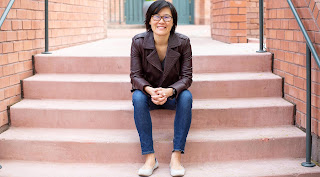A Second Skin: Writing, Memory, and Clothes
Writers’Day at Bay Path is coming up in two weeks, on Feb. 15! Seven very different and accomplished writers
will be on hand for a lively day of discussions and workshops on memoir
writing, publishing, food writing, and children’s books. One of our guest writers, Elizabeth Peavey,
will also perform that evening, in a solo play she wrote about her mother’s
clothes, My Mother’s Clothes Are Not My Mother.
Clothing—that
of others or our own—can be both a powerful memory trigger and a literary subject
in its own right. I’m thinking right now
of the play Love, Loss and What I Wore by
Nora and Delia Ephron, based on the illustrated memoir by Ilene Beckerman. Who can
resist a memoir that opens with an image of a Brownie uniform? (Immediately, I’m back in the basement of a
rec center making a “beach cabana” with a giant communal box of Elmer’s glue
and a constantly collapsing pile of popsicle sticks.) Or ASecond Skin, a favorite collection of stories and essays by prominent
writers (Margaret Atwood, Joyce Carol Oates, A.L. Kennedy) that explore the
significance of clothes which have marked a particular point in their lives. A mother’s sumptuous red velvet dress, a lost
cashmere coat, a pair of ridiculously beloved stripey socks: all serve in these
narratives as Proust’s famous madeleine.
This
morning, thinking about Elizabeth Peavey’s upcoming show, I find myself
remembering not my mother’s clothes but instead the outfits she chose for me. Specifically,
I’m recalling a red plaid dress with a white sailor collar, worn with white
ankle socks trimmed with lace and a pair of clunky Oxford shoes. The year was 1969, my father’s new business
had gone bankrupt, and my parents, unable to afford even the school’s modest
tuition, withdrew my siblings and I from St. Francis De Sales School and transferred
us to Fremont Elementary. At first, I
was exultant. No more ugly uniforms, no
more tight-lipped Sister Agnes and her obsession with exposed knees. I could wear color! Skirts above the knee! I wouldn’t have to
cover my head anymore in morning chapel (we were given caps for this purpose,
which itched and wouldn’t stay put).
My
joy was short-lived.
The
first day at Fremont I was packed off with a “Lost in Space” lunch box, wearing
the above-mentioned red plaid dress, my feet stuffed into the lace-up shoes and
my hair forced into tight pincurls. “You
look just darling,” my mother said, sealing my doom. “Darling,” as it turned out, cut no ice at
Fremont. I crept into Mr. Citarella’s
fifth-grade class to find a sea of girls in Peter Max minidresses, go-go boots,
and hot pink fishnet stockings. (Fishnets!
Sister Agnes would have a heart attack on the spot.) Their hair was long
and straight, their attitude tough and appraising. Some even wore white lipstick. I wouldn’t be allowed lipstick of any kind or
color until high school, my mother had made clear, and here were ten- and eleven-year-olds
with Yardley Lip-Smacker in Silver Frost boldly visible on their pouty
mouths. Cool, the outfits telegraphed.
Modern, fashionable, free. “Dork!” screamed my red plaid ensemble. And dork it was, instantly and irrevocably, a
label that lasted, as it turned out, for years.

There
were other reasons for my social failure besides the radioactive sailor collar,
the “taunt me now” ankle socks. I
carried library books with me to the playground, and sat alone on a bench reading
Little Women while my classmates
raced, screaming, across the grass or bounced basketballs off each other’s
heads. I took piano lessons, not guitar,
in which I learned to play “hit” songs like “Born Free” (“As free as the wind
blows, as free as the grass grows…”). I
got As in school, which made the teachers like me, which made Mrs. Rankin (no, please don’t, please don’t) think it
was a good idea to have me read my essay about cats in front of the class.
But
it’s the outfits I think of first when I remember my agonizingly long dork
phase: the baggy Lee’s jeans instead of the mandatory Levis. Childish socks instead of purple tights. A summer “pool” dress my grandmother made of
two matching bath towels splashed with a design of giant roses and stitched together,
an outfit that so mortified me I cried each time I was told to put it on. “But
it’s so cute,” my mother insisted. “Just
perfect to throw on over your bathing suit.”
(My sister’s was identical, except her roses were gold.) My pleas for go-go boots and miniskirts, for
bellbottoms and pierced ears, fell on deaf ears. “You don’t want to look cheap,” my mother
informed me, her lips tightening like Sister Theresa’s when I arrived for Mass
one morning with my head uncovered. She
seemed blithely unaware that “cheap” was exactly what I wanted to look like. I had no idea what it meant, but I knew I was
desperate for it.
I
wanted clothes to help me make friends.
I wanted clothes to protect me from mockery, to announce to the world
that I, too, was in on the secret of growing up. Sailor collars were for little girls; I was
anxious to leave childhood—that realm of the powerless, of the small and frightened—as
far behind as I could. The right clothes,
I believed, would get me there.
Now,
what they do for me is bring back a time so vividly I can smell the strawberry lip
gloss, hear the Monkees’ “Last Train to Clarksville” blaring over the
loudspeakers at the public pool. And see
the ten-year-old clutching her library copy of Little Women, unaware then that books, not clothes, were someday
going to take her precisely where she wanted to go.


Comments
Post a Comment